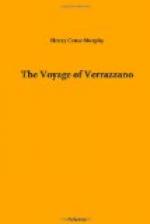cosmography of Alfonse, in Bib. Nat. of Paris,
fol. 185.) Alfonse states that he ran down the coast
as far as a bay which he did not penetrate, in latitude
42, between Norumbega and Florida, showing that Norumbega
was considered as north of that parallel of latitude.
He particularly describes it in the manuscript just
cited, which Hakluyt had before him, as the ruttier
of Alfonse which he publishes is found in that manuscript.
It appears to have been written by Alfonse in 1544-5,
which was shortly after his return from Canada with
Roberval. the name of Norumbega is found in the discourse
of the captain of Dieppe, written in 1539, and printed
in third volume of Ramusio. This writer distinctly
states that the name was derived from the natives.
The description of the country and its inhabitants
given by Alfonse, is important, as showing its extent,
and alluding to the trade there in peltries thus early.
It is found in the cosmography in connection with
the ruttier before mentioned (fol. 187-8), and is
as follows: “I say that the cape of St.
Jehan, called Cape Breton and the cape of the Franciscaine,
are northeast and southwest, and take a quarter of
east and west and there is in the route one hundred
and forty leagues. And here makes a cape called
the cape of Noroveregue. This said cape is at
forty-five degrees of the height of the arctic pole.
The said coast is all sandy land, low without any
mountain. And along this coast there are several
islands of sand and coast very dangerous, with banks
and rocks. The people of this coast and of Cape
Breton are bad people, powerful, great archers and
live on fish and flesh. They speak, as it were,
the same language as those of Canada, and are a great
nation. And those of Cape Breton go and make war
upon those of Newfoundland (Terre neufve), where they
fish. On no account would they save the life
of a person when they capture him, if it he not a
child or young girl, and are so cruel that if they
find a man wearing a beard, they cut his limbs off
and carry them to their wives and children, in order
to be revenged in that matter. And there is among
them much peltry of all animals. Beyond the cape
of Noroveregue [Cape Sable] descends the river of
the said Noroveregue which is about twenty-five leagues
from the cape. The said river is more than forty
leagues broad at its mouth, and extends this width
inward well thirty or forty leagues, and is all full
of islands which enter ten or twelve leagues into
the sea, and it is very dangerous with rocks and reefs.
The said river is at forty-two degrees of the height
of the arctic pole. Fifteen leagues within this
river is a city which is called Norombergue, and there
are in it good people and there is much
peltry of all animals. The
people of the city are clothed with peltry, wearing
mantles of martin. I suspect the said river enters
into the river of Ochelaga, for it is salt more than
forty league inward, according to what is said by the
people of the city. The people use many words,
which resemble Latin, and adore the sun; and are handsome
and large men. The land of Norobregue is tolerably
high. On the side on the west of the said city
there are many rocks which run into the sea well fifteen
leagues; and on the side towards the north there is
a bay in which there is a little island which is very
subject to tempest and cannot be inhabited.”




